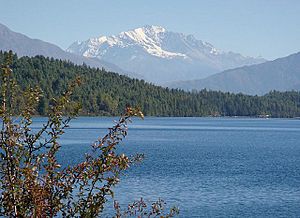Lake Rara facts for kids
Quick facts for kids Lake Raraराराताल |
|
|---|---|

Lake Rara, May 2005
|
|
| Location | Mugu District |
| Coordinates | 29°31′33″N 82°05′25″E / 29.525721°N 82.090211°E |
| Type | Natural, oligotrophic |
| Primary inflows | Many small streams |
| Primary outflows | Nijar khola → Karnali River |
| Basin countries | Nepal |
| Max. length | 5.1 km (3.2 mi) |
| Max. width | 2.7 km (1.7 mi) |
| Surface area | 9.8 km2 (3.8 sq mi) |
| Average depth | 100 km (62 mi) |
| Max. depth | 167 m (548 ft) |
| Water volume | 0.98 km3 (0.24 cu mi) |
| Surface elevation | 2,990 m (9,810 ft) |
| Frozen | never |
| Islands | none |
| Settlements | none |
Rara Lake (Nepali: राराताल raratal) is the biggest natural lake in Nepal. It is located in the Mugu District of Nepal's Mid-Western area.
The lake has a slightly oval shape. It is completely inside the Rara National Park. Rara Lake is about 300 km (190 mi) north-west of Kathmandu, which is the capital city of Nepal.
About Rara Lake
Lake Rara is very high up, at an altitude of 2,990 metres (9,810 ft) above sea level. It covers a large area of 9.8 km2 (3.8 sq mi). The lake is 5.1 kilometres (3.2 mi) long and 2.7 kilometres (1.7 mi) wide. It is also very deep, reaching a maximum depth of 167 metres (548 ft).
Water from Lake Rara flows out into the Nijar river (Nijar Khola). This river then joins the Karnali river. Scientists have called Lake Rara "oligotrophic." This means it is a very clean lake with very little pollution.
Climate Around the Lake
The climate in the Rara National Park, where Lake Rara is found, is a temperate climate. This means it has mild temperatures.
In summer, temperatures can reach about 27 °C (81 °F). In winter, it gets colder, with temperatures dropping to about −4 °C (25 °F).
Animal Life in Rara Lake
Rara Lake is home to some special animals that are found nowhere else. These animals are called endemic species.
- Fish: There are three types of fish that live only in Lake Rara. Their scientific names are Schizothorax macrophthalmus, S. nepalensis, and S. raraensis.
- Frogs: One type of frog, called Paa rarica, is also unique to this lake.
Many different waterfowl (water birds) come to Lake Rara to spend the winter months. Some of these birds include:
- Gadwall
- Mallard
- Northern shoveler
- Eurasian teal
- Tufted duck
- Common goldeneye
- Goosander
- Eurasian coot
- Solitary snipe
Images for kids
See also
 In Spanish: Lago Rara para niños
In Spanish: Lago Rara para niños





